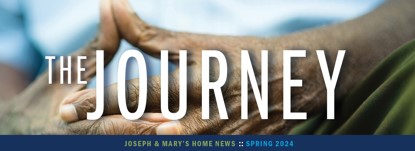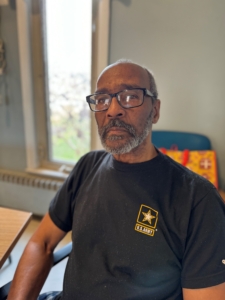The recent issue of The Journey, the biannual newsletter of Joseph & Mary’s Home, features a cover article about how we are adapting to serve a growing population of older adults experiencing housing instability. The newsletter also reports on outcomes and financials from 2023, a donor spotlight on a couple with a giving spirit, the 2023 donor honor roll, a staff spotlight and news updates.
Below is the text from the cover story. Read the complete newsletter here.

Sliding Into Homelessness
Joseph & Mary’s Home Adapts to Serve a Growing Population of Older Adults Experiencing Housing Instability
Gary “Sarge” Cooper is 73-years old and a resident at Joseph & Mary’s Home. He has been in and out of shelters for two decades while trying to make ends meet. An Army Reserve veteran, Sarge has held many jobs throughout his lifetime that range from managing food service at a corrections facility to truck driving. He is emblematic of a growing trend in the United States: an increasing number of older adults are finding themselves without a stable place to live.
In Cuyahoga County, one in four adults experiencing homelessness is age 55 or over. Nationally, older adults are the fastest-growing segment of the homeless population. Researchers predict that by 2030, the number of people 65 and older who are experiencing homelessness will almost triple .
The reasons for housing instability for many of these older adults vary, but climbing housing costs combined with fixed incomes, unemployment and medical issues play a big role.
For Sarge, medical issues worsened his housing instability. In late 2022, he was in emergency shelter at the City Mission in Cleveland. He had a leg injury that had him in and out of several local hospitals for surgery and treatment. During the course of his treatment at Cleveland Clinic, he was diagnosed with cancer. His caregivers referred him to Joseph & Mary’s Home to have a place to safely recuperate while receiving chemotherapy.
in emergency shelter at the City Mission in Cleveland. He had a leg injury that had him in and out of several local hospitals for surgery and treatment. During the course of his treatment at Cleveland Clinic, he was diagnosed with cancer. His caregivers referred him to Joseph & Mary’s Home to have a place to safely recuperate while receiving chemotherapy.
Sarge – and other older adults experiencing homelessness – have unique needs compared to other populations experiencing homelessness. At Joseph’s Home, Sarge uses a rollator and has a private room on the first floor, steps away from the dining room and common area. Unlike traditional shelters, he is grateful to know that he has a reserved room where he can rest during the day after chemotherapy treatments.
“Joseph’s Home is unique in that it is smaller and more personal than traditional shelters,” said Sarge. “They have the right staff to address your personal medical and other needs.”
Since opening in 2000, Joseph & Mary’s Home has responded to evolving community needs. That continues to be true today in the considerations staff makes to accommodate aging and the changing demographics of residents being served.
Joseph & Mary’s Home follows a number of best practices for serving older adults experiencing homelessness, including offering:
- Handicap accessible buildings, like Mary’s Home, that are single-story with wide doors and hallways, and walk-in private showers.
- Assessments and care coordination, with all residents receiving a fall risk assessment.
- Prescription management.
- Behavioral health screenings and referrals. As a residence facility, staff have the opportunity to observe symptoms and help increase communication with each residents’ behavioral health provider.
- Housing plans developed with each resident that takes into consideration their physical and social needs. For instance, an apartment with elevator access. Or, for some people, having a conversation about assisted living or a nursing home, where they will receive the care they need.
“We have weekly meetings to review care coordination and are taking a more comprehensive approach for the older adults we serve. We are focused on long-term success. This means taking the time to understand, unpack and address complex health and social barriers,” said Respite Care Manager Raven Lugo. “We are also intentional about staying in touch with older alumni once they are housed to make sure they are connected with their medical team and have support and resources.”
In addition to the services around medical stability, housing stability and social influences of health that Joseph & Mary’s addresses, accommodating Sarge’s unique needs has helped him on his path to better health and stable housing.
“To work here, you have to have compassion and hope. I see it in all the staff. I’ve been in the shelter system for years and Joseph & Mary’s Home is a special place,” said Sarge. “I’m on the list for an apartment and look forward to the day I get my key.”
SIDEBAR
55 is the New 75: The Toll of Housing Instability
The experience of homelessness is traumatic physically and emotionally. It can age people significantly beyond their chronological age. In fact, a study by University of Pennsylvania researchers found that the toll of housing instability can age people by 20 years. A 55-year-old adult may experience geriatric medical conditions like cognitive decline and decreased mobility at rates compared to a 75 year-old housed adult. People experiencing homelessness aged 50 and older are often considered “older adults,” whereas the older adults are more commonly considered age 65 and older for the broader population.


